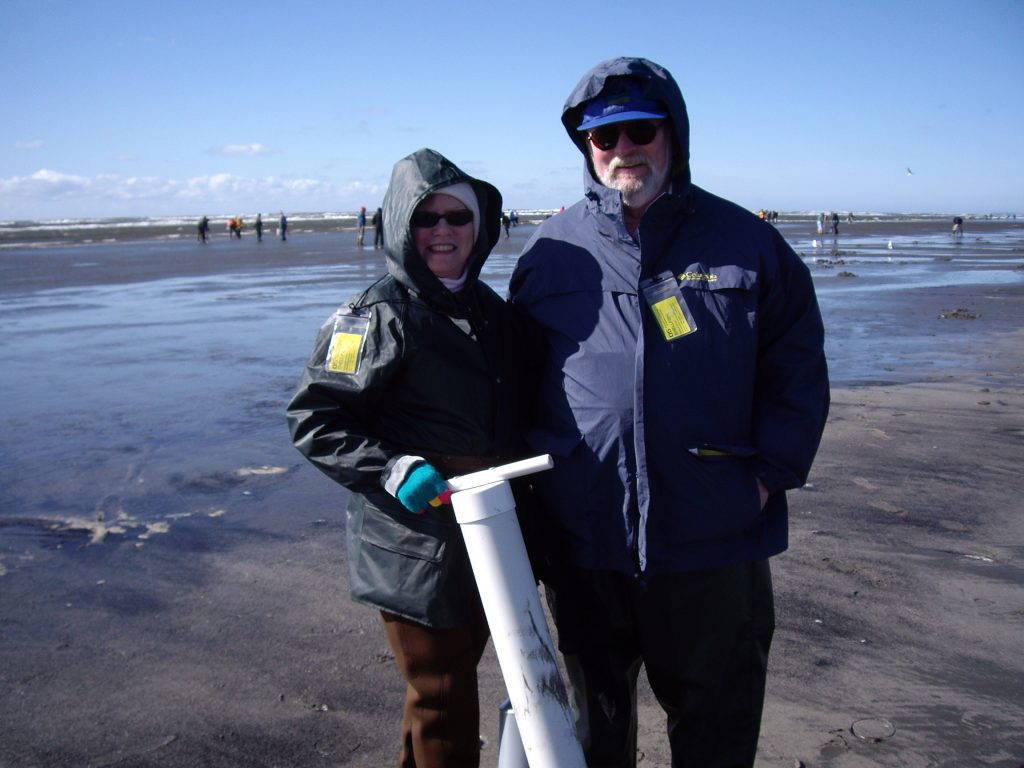The ranger was quite clear on the point: there were no dead birds on his beach at Saltwater State Park, and if he had his way, there never would be. To be sure of this, he checked the beach frequently and removed any bodies he came across.

Brian and Kathy Linnell listened in dismay. It was 2007, and as new COASST volunteers they were supposed to survey the beach at the park, in Puget Sound, which was close to their home in south Seattle. But now they would apparently have to look elsewhere if they wanted collect data on beached birds. So they traded one state park for another, and twelve years later, after more than one hundred surveys of their beach at Ocean City State Park on the outer coast, Brian and Kathy are retiring from COASST.
Both Linnells grew up in the Midwest—“we’re flatlanders,” Brian says—but they had lived on Lake Superior, so they were used to the idea of large bodies of water. They moved to the Pacific Northwest in 1982 for jobs—Brian was an accountant, Kathy a nurse—and settled in the Seattle area. Transferring their allegiance from freshwater to salt was not difficult; they both loved living near the ocean, and were always interested in the life it held. Kathy volunteered as a beach naturalist, while Brian liked to fish. Eager to learn more, they started going to public lectures about the ocean and marine issues.
One day, they went to a lecture at R.E.I. in Seattle. The speaker that day was Julia Parrish, and she was there to talk about COASST and the importance of citizen science. The project intrigued the Linnells. “It was really interesting hearing her talk about the COASST data and everything they were able to do with it,” Kathy says.
The Linnells decided to join COASST, and after their contretemps at their first site, they took to Ocean City. “It’s a big beach with sand dunes that stretch quite a ways back,” Brian says. “It’s a busy beach, too, with razor clamming, and lots of people there generally for recreation.” Such busyness has given the Linnells plenty of opportunities do engage with citizens while doing their own science. “People come up to you and ask what you’re doing,” Brian says. “COASST can be quite a conversation opener. You talk about dead birds, and people look at you kind of funny, but they’re interested once you tell them what’s going on.
Mostly, though, what the Linnells have enjoyed is the dynamism of their site. “The beach is always changing, and we feel so appreciative that we were there to watch them happen,” Kathy says. The sand never settled; the longer the Linnells went, the more they saw that surprise was the rule. “We used to think, Oh, it’s March, so we’re going to see X, Y, Z,” Kathy says. “But that wasn’t true. The aftermath of storms was always interesting. Sometimes the beach would be loaded with wrack and logs, and sometimes there was nothing.”

In time, though, the monthly hundred-odd-mile drive from Seattle out to Ocean Shores got to be a little much. But even as they hand their beach off to someone else, the COASST impress never really goes away. “A friend of ours in Alaska signed up for COASST,” Brian says. “And we have a friend in Washington, D.C., who volunteered with us and now sends us articles about dead birds.”
Besides, now they can turn their attentions to living birds, of all things. “At a refresher training session,” Kathy remembers, “we learned we had found the most dead murres of all the volunteers, but when we looked at a picture of a murre, we didn’t recognize it because it was alive!” She laughs. “So going now will be a nice change in that sense.”
Post by Eric Wagner
